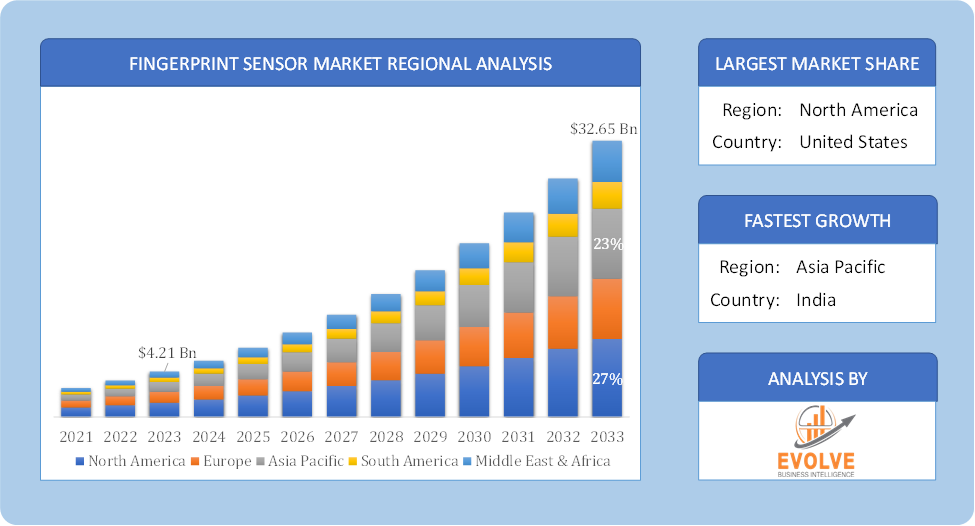Blog
The Fingerprint Sensor Market Is Estimated To Record a CAGR of Around 16.65% During The Forecast Period

Evolve Business Intelligence has published a research report on the Global Fingerprint Sensor Market, 2023–2033. The global Fingerprint Sensor Market is projected to exhibit a CAGR of around 16.65% during the forecast period of 2023 to 2033.
Evolve Business Intelligence has recognized the following companies as the key players in the global Fingerprint Sensor Market: Shenzhen Goodix Technology Co. Ltd., Fingerprint Cards AB, Apple Inc., Synaptics Incorporated, Egis Technology Inc., FocalTech, id3 Technologies, IDEX Biometrics, OXi Technology and Sonavation Inc.
For More Information : https://evolvebi.com/report/fingerprint-sensor-market-analysis/
Market Highlights
The Global Fingerprint Sensor Market is projected to be valued at USD 13.54 Billion by 2033, recording a CAGR of around 16.65% during the forecast period. The fingerprint sensor market is the industry that designs, develops, manufactures, and sells fingerprint sensors. These sensors are used in a variety of devices, including smartphones, laptops, tablets, access control systems, and point-of-sale terminals. Fingerprint sensors are a type of biometric technology that uses a person’s unique fingerprint to identify them.
The fingerprint sensor market is a growing market, driven by the increasing demand for security and convenience. Fingerprint sensors are seen as a more secure way to identify a person than traditional methods such as passwords or PINs. They are also more convenient, as they do not require users to remember complex codes.
The COVID-19 pandemic had a significant impact on the Fingerprint Sensor Market. The pandemic caused disruptions in the global supply chain, leading to delays in the production and delivery of fingerprint sensors. Manufacturing plants faced shutdowns or operated at reduced capacity, affecting the availability of components and finished products. With lockdowns and remote working becoming widespread, there was a reduced demand for fingerprint sensors in sectors like automotive and physical access control systems. The decline in consumer spending also impacted the sales of consumer electronics such as smartphones and laptops, which are major end-users of fingerprint sensors. The pandemic heightened awareness of hygiene and the need to avoid contact surfaces, leading to a shift towards contactless biometric solutions such as facial recognition and iris scanning. This impacted the demand for fingerprint sensors, as contact-based authentication methods were seen as potential vectors for virus transmission.
Segmental Analysis
The global Fingerprint Sensor Market has been segmented based on Type and Technology.
Based on Type, the Fingerprint Sensor Market is segmented into Swipe, Area and Touch. The Area and Touch segment is anticipated to dominate the market.
Based on Technology, the global Fingerprint Sensor Market has been divided into the Capacitive, Optical, Thermal and Ultrasonic. The Optical segment is anticipated to dominate the market.
For More Information : https://evolvebi.com/report/fingerprint-sensor-market-analysis/
Regional Analysis
The Fingerprint Sensor Market is divided into five regions: North America, Europe, Asia-Pacific, South America, and the Middle East, & Africa. The North American market for fingerprint sensors is a mature market. However, the market is expected to continue to grow due to the increasing adoption of new technologies such as in-display fingerprint sensors. The European market for fingerprint sensors is also expected to grow steadily. The increasing adoption of smartphones and wearables, along with growing security concerns, is driving the market growth in this region. Asia Pacific region is currently the largest market for fingerprint sensors and is also expected to witness the highest growth rate during the forecast period. The large population base, increasing demand for secure authentication solutions, and government initiatives promoting digitalization are driving the market growth in this region. Latin America region is growing awareness and adoption of biometric technologies, though at a slower pace compared to North America and Asia-Pacific. Rising security concerns drive the demand for fingerprint sensors in banking, government, and consumer electronics and Increasing focus on enhancing security and reducing fraud. Governments in the Middle East and Africa region are increasingly adopting biometric identification for national ID programs and border control. High demand for secure authentication methods in various sectors, including banking, government, and healthcare and rising security concerns and the need for efficient identification methods.


